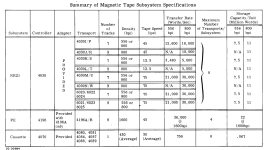If you happen to see my other post, I've been reading about the early days of the computer market during the 1970s. The books I've read mention punch cards, paper tape, and audio tapes.
I was wondering which of the three was the most reliable loading programs? My first computer was a Commodore 64 with a tape drive in 1983. I never had any issues, but at school the Atari's, Tis', and Apple's had a terrible time loading tapes. The school switched to all disk drives fairly quickly because of the tape issues. At the time I was told Commodore's interface was much more reliable. I didn't know if the Altair (and others) had the same issues loading from audio tapes?
This may sound dumb, but was audio tape faster to load than punch cards and paper tape?
Lastly, how much information could be stored on a single punch card and paper tape? Did one punch card = X amount of bytes and X inches of paper tape = X amount of bytes?
Thanks for sharing your knowledge!
I was wondering which of the three was the most reliable loading programs? My first computer was a Commodore 64 with a tape drive in 1983. I never had any issues, but at school the Atari's, Tis', and Apple's had a terrible time loading tapes. The school switched to all disk drives fairly quickly because of the tape issues. At the time I was told Commodore's interface was much more reliable. I didn't know if the Altair (and others) had the same issues loading from audio tapes?
This may sound dumb, but was audio tape faster to load than punch cards and paper tape?
Lastly, how much information could be stored on a single punch card and paper tape? Did one punch card = X amount of bytes and X inches of paper tape = X amount of bytes?
Thanks for sharing your knowledge!



